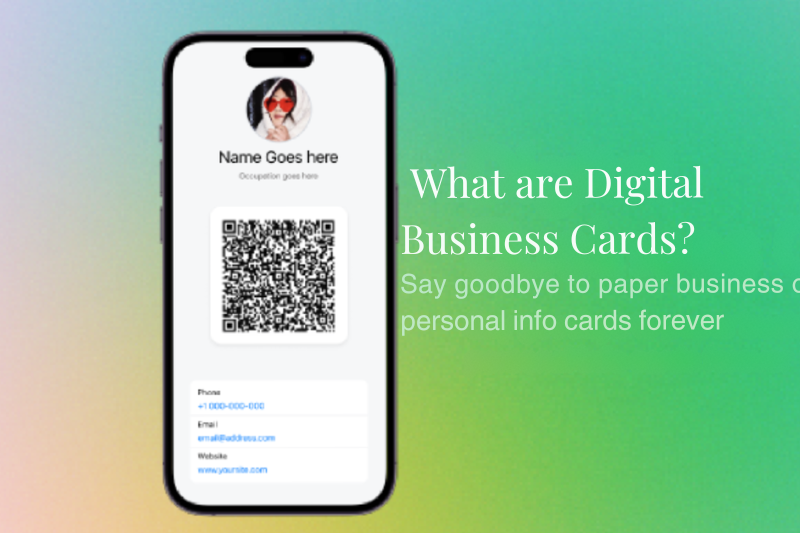Have you ever wondered whether it’s better to hand someone a traditional paper business card or send them a sleek digital version with just a tap or scan? If yes, you’re not alone!
Today, the choice between digital vs physical business cards has become more important than ever. With networking happening both online and offline, professionals are debating which card makes the strongest impression and serves their needs best.
In this article, I’ll walk you through everything you need to know — benefits, drawbacks, comparisons, and even some personal tips to help you choose wisely.
🧾 What Are Physical Business Cards?

Physical business cards are small printed cards that include your name, title, company, contact information, and sometimes a logo or design that reflects your brand. You hand them out during meetings, events, conferences, or chance encounters.
They’ve been used for decades and still play a major role in face-to-face networking.
🔍 Benefits of Physical Business Cards
- Memorable and Tangible
A physical item leaves a lasting impression. People tend to remember you better when they physically receive something. - No Tech Required
No battery, no Wi-Fi, no app—just a simple exchange. Very helpful in places with limited technology access. - Professional Appeal
A well-designed card with quality material shows that you take your business seriously. - Works Well in Formal Settings
In traditional industries like law, real estate, and healthcare, physical cards are still the standard.
⚠️ Drawbacks of Physical Business Cards
- Easily Lost or Damaged
Cards can be misplaced, torn, or forgotten in someone’s pocket. - Can’t Be Updated
Changed your phone number or job title? You’ll have to reprint the entire batch. - Environmental Impact
Paper waste from discarded cards is a concern, especially for eco-conscious professionals. - Limited Space
Only so much can fit on a 3.5 x 2-inch card.
You may also like to read these posts :
https://printcod.com/wp-admin/post.php?post=82&action=edit
https://printcod.com/wp-admin/post.php?post=88&action=edit
https://printcod.com/wp-admin/post.php?post=96&action=edit
https://printcod.com/wp-admin/post.php?post=108&action=edit
🌐 What Are Digital Business Cards?

Digital business cards are the modern version—virtual cards you can create and share electronically through email, text, apps, or QR codes. They carry all the information a physical card has, but with interactive features like:
- Clickable links
- Social media profiles
- Videos
- Maps
- Portfolios
✅ Benefits of Digital Business Cards
- Instant Sharing & Accessibility
You can send your card in seconds—no printing, no shipping, no waiting. - Always Up-to-Date
Make updates any time without reprinting or redesigning. - Eco-Friendly
No paper, no waste. It’s a sustainable alternative for environmentally aware professionals. - Interactive & Engaging
You can include links to your website, booking calendar, testimonials, and even videos. - Cost-Effective
Many digital card tools offer free or low-cost plans. - Wider Reach
You can share your card globally, not just locally.
⚠️ Drawbacks of Digital Business Cards
- Requires Technology
Not everyone is comfortable with digital tools, especially in older age groups or low-tech industries. - Less Personal Touch
Sending a link isn’t quite the same as a face-to-face interaction with a handshake. - May Be Overlooked
Inboxes and phones are crowded. Your digital card might get lost in the shuffle. - Compatibility Issues
Some apps or platforms aren’t supported across all devices.
📊 Digital vs Physical Business Cards: In-Depth Comparison

| Feature | Digital Business Cards | Physical Business Cards |
| Ease of Sharing | Instantly via phone, QR code, or email | Must be handed over physically |
| First Impression | Modern and innovative | Traditional and professional |
| Environmental Impact | Eco-friendly, no waste | Contributes to paper waste |
| Update Flexibility | Easy and instant updates | Requires reprinting |
| Cost | Often free or low-cost | Ongoing cost for printing and design |
| Design Flexibility | Can include video, links, and animations | Limited to print graphics |
| Durability | Cannot be physically damaged | Can be bent, torn, or lost |
| Technology Required | Needs a smartphone or internet | None |
| Reach | Can be shared globally and virtually | Limited to in-person meetings |
| Memorability | May be ignored or deleted | Leaves a physical mark in memory |
💡 My Personal Advice: Why Not Both?
In many cases, you don’t have to choose only one. Smart professionals use both digital and physical business cards to cover all situations.
Here’s a simple plan:
- Keep physical cards with you for traditional events, formal meetings, and older professionals.
- Use digital cards for online networking, tech-savvy clients, or remote communication.
Some digital card apps even let you create a QR code you can print on your physical card, combining both worlds!
🧠 Real-Life Scenarios: Which One Works Best?
- At a conference booth? Go with physical cards — quick and expected.
- In a Zoom meeting? Drop your digital card in the chat.
- Pitching a startup? Use a digital card to show you’re tech-forward.
- Meeting an executive from a traditional industry? A physical card may be more appropriate.
📌 Final Thoughts
Choosing between digital vs physical business cards really comes down to how you work, who your audience is, and what message you want to send.
- If you want eco-friendly, flexible, and interactive, go digital.
- If you prefer personal, tangible, and simple, go physical.
- If you want to cover all your bases, do both.
Whichever you choose, the most important thing is to make it professional, clear, and memorable. After all, your business card is often your first impression — so make it count!
❓ (FAQs)
Q1: What’s the main difference between digital and physical business cards?
A: A physical business card is printed on paper and handed out in person. A digital business card is shared electronically—through a link, QR code, or mobile app—and often includes clickable features like email, websites, and social media.
Q2: Are digital business cards better for the environment?
A: Yes, digital cards are eco-friendly. They don’t require paper, ink, or printing, which helps reduce waste and carbon footprint. If you’re environmentally conscious, this is a big plus
Q3: Can I still use physical business cards in 2025?
A: Absolutely! Many professionals still prefer physical cards, especially in formal settings, face-to-face meetings, or industries where tradition matters. They’re not outdated yet.
Q4: What happens if I lose my digital business card?
A: Since digital cards are stored online or in apps, you don’t really “lose” them. You can access or share them anytime from your phone, email, or cloud account. It’s actually harder to lose a digital card!
Q5: Do I need a specific app to create or view a digital business card?
A: Some platforms require their app for full features, but many digital cards can be viewed through any browser or by scanning a QR code. Apps like HiHello, Canva, and Beaconstac offer great options without needing the recipient to download anything




